by Marion Patterson | Jun 26, 2025 | (Sub)Urban Homesteading, Garden/Yard, Mammals, Pests
What’s In A Name?
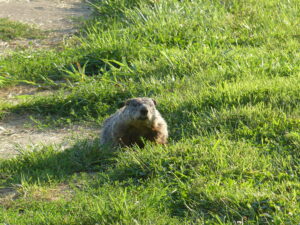
Nibbling on grasses
A big furry animal has made a tunnel under the deck and clear cut down the garden. Is the culprit a woodchuck or groundhog? The answer is simple. They’re two names for the same animal.
The window by Marion’s computer desk overlooks our deck. On a spring morning, she was startled to look out and be face to face with a big woodchuck just outside the glass.
He soon ambled off. A few days later, we were enjoying basking in the sun in our outdoor nook. It’s next to a front lawn that we seeded with white clover last year. Out of the corner of our eye, we caught movement. It was the woodchuck, likely on his way to enjoy a clover lunch. When he spotted us, he quickly exited.
What is a Woodchuck?
Several species of marmots live across the northern hemisphere. Visitors to western national parks often see the Yellow-Bellied Marmot in higher elevations, but the one most Americans spot is the amazingly abundant woodchuck.
Woodchucks live in both suburban and rural areas from the Atlantic Ocean westward to Nebraska and Kansas and north to Hudson’s Bay and even Alaska.
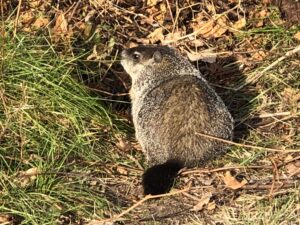
Woodchucks are great tunnelers.
They are an amazing adaptable vegetarian. Among North American rodents only beavers are bigger. A huge male “chuck” can weigh up to 15 pounds. As rodents they have impressive incisor teeth and powerful legs perfect for digging burrows under decks or inside or near old sheds and brush piles.
True hibernators, male woodchucks emerge from their burrows in March here in Iowa. Females wait a few weeks and usually end their winter slumber in April. They’ll soon have three to five pups. As soon as the babies’ eyes open, mom will bring them outside where they learn to dine on a wide range of vegetation. They love garden vegetables. Perhaps nothing is as tasty as beans, lettuce, or Swiss chard.
Tree Climbers?
Most people realize woodchucks are excellent diggers, but few recognize they are squirrels adept at climbing trees. On hot summer afternoons, they love resting on a shady and breezy tree branch.
Reducing Woodchuck Damage
Although they’re big and active during the day, woodchucks are wary and usually vanish when they spot a person. They can’t hide the huge mound of dirt by their burrow, and a clear-cut bean patch also may mark their presence.
How do you reduce woodchuck damage? Since they can burrow, run, and climb, it’s challenging keeping them out of a yard or garden.
These Actions Can Help
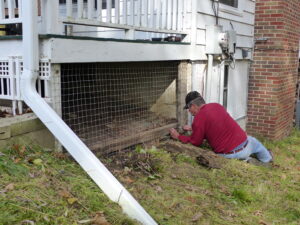
Rich placing wires to prevent woodchucks from digging under the porch.
Fencing: A stout fence around a garden or deck can make access challenging. The fence needs to be dug into the ground. Placing a mesh of stout fencing on the ground under a deck will reduce the odds that a chuck will burrow there, but it has to be done before the animal starts making its home.
Dog: An alert dog will chase chucks away.
Altering the yard: Removing brush piles where chucks like to burrow will encourage them to create a home elsewhere.
Trapping: Woodchucks are usually easy to catch in a box-type live trap. Set the trap near the burrow and bait it with bits of apple or other fruit. It helps to cover the trap with a tarp or some brush, as they feel more secure underneath something.
There’s a problem
What do you do with a healthy but very unhappy chuck caught in a box trap? Keep fingers out of the trap! Call the town animal control officer(s) and ask for their suggestions on what to do with it. We don’t advocate taking it on a long drive and releasing it in the country. It seems unethical to “give” the animal to someone who lives near the release area. Preventing damage is always best, but sometimes euthanizing a problem chuck is the best solution.
Woodchucks are amazing animals. We enjoy seeing them as long as they stay out of the garden!
by Marion Patterson | May 8, 2025 | Ruminations
Post Two Post-surgery time – Days 1 to 21
Go Slow Now to Go Fast Later
Go to this link for valuable information.
Being on high-level pain medications is interesting. In the hospital recovery, I remember drowsily being aware of voices coming and going. On the post-op floor staff were excellent. Attentive. Not too chatty. But I was chatty. They knocked when entering. Staff identified themselves. Two visitors did not. So, I simply asked who they were. It’s a good habit for everyone who enters to initiate: “Hello, I am ____. I am here to___.” Rich stayed close by.
Our son came in about day ten. A nurse had pointed out that people tend to rush in to help with surgery. When in truth, a person rests/sleeps a lot! So, help later, when others have resumed their lives is often more helpful. That proved to be true for us.
At first, I slept/rested a lot, and was foggy at best. Yet, I managed to periodically get up and trundle around the single-floor home of friends who had us stay. I thought I could do more than was actually wise to do.
Years ago, I was part of an international labyrinth team planning an international virtual facilitator workshop. A wise colleague from Texas reminded us to go slow in planning now to go fast later. Great advise following surgery. And, other situations, too.
Just be patient. Even though I am in fairly good physical shape, I found that as I weaned off medications, body parts that I had forgotten about complained. This is because I was holding my body more tensely and moving irregularly. The HeartMath techniques I have learned and practiced helped. This thoughtful pause of breathing and appreciation helped me center.
Several times a day take “One Good Minute” to breathe deeply. Name and feel what you appreciate. As is appropriate check with your doctor and arrange for a licensed lymph drainage specialist to drain off excess fluids. I learned and practiced lymph drainage which helped in between sessions.
Moving Around:
Face What is Ahead of You
I am always surprised at how often I face one way and start to overreach or twist to get something not directly in front of me. As Doctor Schopick, the neurosurgeon, pointed out, “Face What You Are Doing!“ and “What is Ahead of You.” This is good practice, both literally and figuratively. Denial usually creates more problems than facing something straight on.
In this case, Nose follows Toes. Walk heel-toe. Shoulders back. Chin up. Draw the low belly up. Use a walker or cane as a guide. Use your peripheral vision to see. Remember, these are “code talk” for “Stop shuffling!” “Stop slouching!” “Suck in your gut!” “Release the death grip on the walker/cane!”
Use the stairs’ railing as a guide instead of pulling up or pushing down. I found a comfortable way to descend stairs first thing in the morning when I was stiff was to step down sideways, gripping like the Ninja Warriors on TV: one hand over/one hand under.
Other Thoughts
Elevate swollen areas. Long ago, injuries on my left leg created issues with swelling on the ankle and foot. I iced as appropriate and later alternated with heat. Lymph drainage by professionals relieved swelling in areas beyond the surgical sites. I checked with professionals first.
Helpers: Keep the house tidy. This promotes safety and helps the recovering person mentally. I found it helpful to make lists of what I would like done and ask helpers to do a few at a time.
Rest: do one task and lie down. I learned to recognize when I was tired. i.e., Sigh, short-tempered. Achy. Slouching. I would lie down, even when I was sick of lying down.
Reachers: I placed in several locations around the house. Again, a learning process. when an object fell, I breathed and got the Reacher.
Clothing: As my body adjusted to post-surgery recovery, I found that I alternated between being cold and then warm. Easy to take off and put on tops and layers like vests helped. High-waisted, wide-legged pants proved easy to use. The low front and back incisions were exactly where the underpants’ bands rested. Owie! So, a friend suggested, “Go Commando.” Lightweight mini-pads kept my pants clean for the several days I needed them.
Meals: People are willing to help. We arranged the Meal Train for every few days. (Other programs exist). People brought more food than one meal. Also, this became a time for short visits. Spread out meal offers longer than you think you might want them as this is also a social time. At about two weeks, I felt like and could make meals but felt isolated, so visits were nice.
Visitors: We all have different social personalities. Even social, spontaneous folks may prefer a more structured, pre-planned visit time. (phone or in person.) I found it helpful to ask folks to email vs text to see when I might want to visit or talk on the phone. Unless you put the phone on mute, texts disrupt your rest.
Be Specific: Tell people specifically what you do appreciate and do not want or need. i.e., no war stories. Keep visits to 30-45 minutes. If you do not want/need flowers/plants, tell people. Suggest other ways for them to connect. i.e., meals, cards over time beyond the initial phase, taking you on short drives, arranging phone calls, and short visits, help keeping the house tidy. Spontaneous drop-ins can be problematic. You may be tired, have just laid down, having a harder day. Getting to the door takes time. Visiting takes enormous energy. We have amazing friends who helped with household cleaning tasks. Bathrooms and vacuuming were two enormous helps.
Areas the medical community could help with: Show and have clients practice how to use a walker and cane. I didn’t know for weeks to use the cane on the opposite side of the injured body. Call three days post-surgery and ask, “What are you experiencing?” Advise on scar rehabilitation after it has healed to loosen skin from fascia and other muscles. This promotes flexibility in the future.
Notes, texts, or emails to check in over several weeks to spread out and help you feel connected to the world. I took time to send e-cards or emails to thank them and stay in touch with updates.
Transportation: Allow people to drive you around for a number of weeks. Learn how to get in and out of cars. A great tip on YouTube is to put heavy plastic on the seat to help you slip in and out of the car.
Keep items within reach from knees to shoulders
Keeping Clean: Body wash clothes. No bending beyond 30 degrees. If you remember geometry class, a right angle is the letter L. Half that is 45 degrees. 30 degrees is even less. Go no further! Let the bones and hardware fuse.
Small cups to spit into and rinse mouth. Baby wipes for anus. Dispose in the trash, not the toilet. Otherwise, the wipes can clog up septic and sewer systems. THAT is a big problem. Body wash clothes are handy and safer than soap bars. The latter are slippery, and if one falls from your hand, it could hit your body, which hurts, or you could slip on it. Trying to pick one up with a Reacher is nigh impossible. Body washcloths are soft and easy to grasp with a Reacher.
Caregivers: Do what the person wants. Even if it seems silly or odd. A good way to ask is, “What do you want or need done now?” vs. “Well, let me know if you need anything.” Often our brain cannot function to say, take out the trash, pull frozen meals out of freezer, wash and put away dishes….
Patient: Be patient. Helpers may do things differently than you. If the task gets done, just say thank you.
Family, Friends, and Colleagues: Send encouragement and gentle advice. One childhood friend shared: “I’m so glad you are recovering well. It sure takes time, especially when you consider what you have been thru. Just keep taking it a day at a time, and keep listening to your body like you have been. My experience with my hips taught me to do exactly what the discharge instructions say. I paid for it whenever I tried to do too much too quickly.”
People I work with reminded me to avoid doing things that impede my progress. Take a “pity party, but don’t wallow in it.” And “Be a compliant patient.” So, let’s go for it and do less now to do more later.
Remember, “You Got This!”
by Marion Patterson | Apr 24, 2025 | Ruminations
Caveat
Note, many of these ideas can apply to various situations where one is temporarily limited in movement. Rich has had hand and cataract surgeries. His movements were limited for a time.
My situation was ALIF – low back fusion surgery. There appear to be different levels of this. Below are simply perspectives tactics that I have found helpful.
Take what you find useful. Leave behind anything else.
Above all: Check with your medical team on the efficacy of incorporating any thoughts below. i.e. Primary, surgeon, massage therapist, chiropractor, physical or occupational therapist.
Pre-Surgery:
Get in shape: Lose weight if appropriate. If your doctor advises this: DO IT! Strengthen the muscles you will need to help you move—your legs, arms, and abdomen. Learn to walk in structurally appropriate ways. i.e. Lift toes then step heel-toe. Draw the low belly up. Shoulders back. Chin parallel to ground. If you are using a walker or cane, use it as a guide by gripping it lightly. Use peripheral vision. Face directly whatever you are doing. For example. If you are doing dishes and need something from the countertop, take small steps and face the object you need. This vs. twist and reach for. Practice helps avoid future strain on the affected surgical area.
All this is “code talk” for: Stop shuffling! Stop slouching! Suck your gut in! Stand up straight! Release the death grip on the walker or cane! Pay attention to what is around you.
Practice: standing and sitting up straight.
Practice: upper body strength. Keep shoulders back and arms strong.
Practice: on off chairs, into out of cars.
Practice: weeks ahead: Nose follows toes. Take baby steps vs twist around. Practice: bending from knees vs waist. Realize thighs will initially be sore anyway. As desired, use a topical like “bio freeze.”
Practice: help putting on and taking off compression socks. In my case NO bending from waist or bringing knees above hips for several weeks. It’s tricky to do this. You and your helper will get better over time.
Watch and Practice: Credible YouTube videos. Movement, getting into and out of vehicles. (A great tip was to get a heavy plastic bag that is slippery to help you turn more easily.) Getting up and down off chairs. Into and out of bed. Wrestling with blankets. Using pillows between legs. Bathing. Using toilet/wiping bottom. A flaw with the videos is the occupational or physical therapist is often young, using a bed with no blankets and has not had surgery. You will need to practice ahead to manage well after surgery.
Determine the items you will need ahead.
This site is valuable for deciding what and how to get ready.
Many items you need only temporarily, so there is NO need to buy them. Ask friends if they have items to borrow. Find and use the medical tool lending libraries in your area. Label where items come from (friend, medical tool library). Place where you will need them. Grace Episcopal Church in Cedar Rapids, IA, has an amazing medical tool lending library. Say “thanks” by making a contribution and donating items when you are done.
Some items might be Walkers. Reachers. Canes. Wipes. Wedges for semi-reclining. Grippers for tub safety. Bath stools. Beds and mattresses. Small plastic box to put items in that you need when resting. (lip balm, cheater glasses. phone, hand lotion. Pen/paper. Book.)
-

-
Gather these ahead.
-

-
Keep organized
-
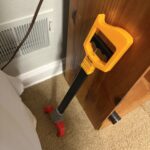
-
Kid’s reacher
Buy disposable items you will need:
Examples are bathing and child body wipes. Clothes easy to put on and off. (i.e. wide legged pants and button-down shirts.) Use Goodwill or other resale shops to save money. Then, donate back when you no longer need these.
Declutter.
Remove unused items and trip hazards. (rugs, objects, pet toys) Get ice and heat packs ready. Check with doctor for when to start using. To avoid caffeine headache, wean off caffeine. Drink healthy liquids and use the restroom. (hot/warm water or tea. Juices. Milk)
Buy and Plug in night lights
Locate the strategic places to help with navigation.
Arrange food for several weeks.
A “Meal Train” type system helps! Schedule for every few days. Most people bring more food than for one meal. Also, you may have less appetite for a few weeks so one meal may go a ways. We found extending this courtesy longer than we initially thought, helped. If someone gives a gift card through an online site, ask them to alert you so you can find it. Look in spam. Otherwise, it will get lost.
Keep a list of people who offer to and have helped. Send notes of thanks. Ecards, real cards, texts.
Gather “entertainment” items:
Realize you may be disinterested initially. When people offer items ask if they want them back or not. If so, be sure they label them so you can return them. Small puzzles, word-type puzzles, books (audio/hard copy).
Make a document of how you like things done.
Ask people to help keep the house tidy. Include the location of cleaning items, bedding, laundry, temperature control, food, dishes/pots/pans. Contacts.
Ask another person, as well as your caregiver, to come to pre-surgery visits with you. The flood of information is overwhelming. These people can listen and understand more than you can.
Personal Care Just Before Surgery
Either wash or have you hair washed and styled immediately before surgery. I could run a brush through my hair and felt half decent for several days. Then I could use the dry wash product on my hair a few times before i was ready to tackle washing hair in the shower. Also, clip your toenails and fingernails right before. I was not to bend beyond 90 degrees – sitting L shape – for at least eight weeks. Toenails can grow really long in that time!
Practice:
When we are more present and aware, we can be more mindful, do meditation, and feel appreciations. Take a few minutes each day to say, Thank you. Breathe deeply. Smile. Release muscles. I programmed HeartMath’s Inner Balance on my phone to chime three times a day. I would pause and breathe in regenerative feelings like calm and appreciation. I’d smile as I remembered how good the sun felt on my face when sitting in the nook; the sound of robins returning; our chickens laying fresh eggs; the song birds at the feeder; a fun note from a friend; a friend’s kindness.
You have prepared yourself and those close to you. Know all will be well.
by Marion Patterson | Apr 3, 2025 | Mammals
An odd shed deer antler caught our eyes during a woodsy March walk. We’ve enjoyed shed hunting for years and have found plenty, but this one was unusual.
What is a Shed?
Deer, elk, moose, and caribou all shed their antlers a couple of months after the breeding season. Usually in January and February the antlers loosen from the bucks’ heads and fall off. We’ve learned to seek sheds in places where a deer jumps over a fence or crosses a stream in a deep valley. The jar caused by the jump or climb sometimes dislodges the antlers. Sometimes just one drops and the other at some other place. Other times, one can find a matching pair of sheds. Gold!
Oddity
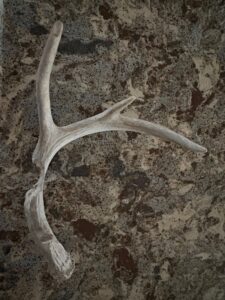
Odd find.
The antler we found recently wasn’t especially large, but its location was weird. It was four feet off the ground in the branches of a tall shrub. We guess that the buck was walking through thick shrubbery when his nearly ready to fall off antler caught in the branches and came off. That’s unusual but there was one other strange thing about it.
Location and Condition
We walk that trail often but never noticed the antler on earlier walks. It was well-weathered and bleached white. A squirrel had chewed a big notch out of the antler, almost cutting it in two. So, it must have come off the deer about a year before we found it. Why we hadn’t spotted it sooner is a mystery.
Why Shed Hunt?
Antler hunting is a fun outdoor activity. They can be found any month, but the best season for searching is in late winter, just after the deer have shed them, the show has melted, and before spring vegetation grows to hide them.
Matter of Luck
We’ve noticed another odd thing about shed hunting. At least for us. When we go out deliberately seeking them, we sometimes, but rarely, find one. At other times when we’re absent-mindedly rambling through the woods we’ll step on one!
In An Improbable Place
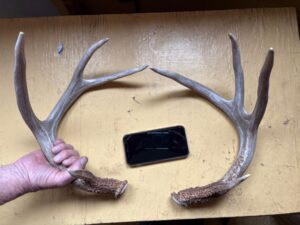
Golden! A pair.
The deer that caught his antler in the shrub likely lived to shed a new set of antlers this year. Maybe our neighbor found it. She was astonished to find two shed antlers on the lawn behind her house, only about 500 yards from where we found the seasoned and chewed one. The new finds were much bigger, but bucks generally grow a larger antler every year.
Keep your eyes open for these fun finds.
by Marion Patterson | Feb 6, 2025 | Nature
On a cold December afternoon Rich bundled up, drove to a friend’s farm, and lugged a lawn chair and hunting gear into the woods. He settled into the chair and sat motionless for nearly two hours. His reward of stillness and dark discoveries was quiet interactions with nature.
Wildlife Carried On
No deer came by but he was thrilled to watch two brown creepers climb up the rough bark of a hickory tree only six feet away. “They didn’t know I was there and I could clearly see them use their tweezer-like bills to dig tiny insects from deep in the bark’s furrows, ” he said.
Minutes later a bluebird perched on a branch around 20 feet away and a gray squirrel scampered within inches of his boots. Chickadees, nuthatches, and woodpeckers went about their business as Rich sat motionless.
He came home without a deer but declared it an outstanding afternoon and a successful “hunt.”
What Stillness Does

Still
Sitting quietly is one of the best ways to enjoy nature. We do it often, but usually, it’s not in the woods. We sit very still on our back deck, especially during pleasant weather. More often our sitting is at our kitchen table, where we watch our resident wild turkeys and deer prance around the yard, and songbirds snatch seeds from our feeders. Once we watched a squirrel approach with a walnut in its mouth. Just outside our window, it buried the nut.
Animal Senses
The senses of wild animals vary. For example, the turkeys who visit our yard have superb eyesight and hearing but a poor sense of smell and taste. In contrast, deer have relatively poor eyesight but outstanding senses of smell and hearing.
Even animals with poor eyesight notice and react to movement. A deer might stare at an immobile person for some time trying to catch a scent, but at the slightest movement, the animal will bolt.
Stillness
To see the most wildlife, rule out fidgeting. Sit still. To observe the widest range of species, sit very still downwind so any scent wafts from the animal toward the person rather than vice versa.
Rich can sit nearly entirely motionless for long periods. Here are his tricks for being still:
Tips for Stillness and Dark Discoveries
- Have a comfortable seat. He finds sling chairs easy to carry into the woods and comfortable to sit in. Sometimes he just brings a foam rubber pad that’s even easier to carry and insulates his posterior from cold and wet ground.
- Dress extra warmly. Movement causes muscles to work and generate heat. Sitting requires warmer clothing than walking on an equally cold day. In the winter Rich wears these items:
- Layers starting with a base layer. We once called them Long Johns. Over them goes a pair of pants and over them goes insulated bib overalls. For his upper body, Rich wears a t-shirt, base layer long-sleeve shirt, light fleece jacket, and, finally, a winter coat.
- Warm footwear. Feet get cold quickly but winter footwear helps keep them toasty. Rich wears a pair of wicking socks under wool socks that fit loosely within his “Pac boots”. These high-top boots have removable felt liners.
- A thick wool stocking cap keeps the noggin warm and a pair of thick mittens does the same for the fingers. When it’s super cold Rich sometimes wears light wool gloves and then slips his hands into mittens, creating a double layer.
Other Comforts for Stillness and
Dark Discoveries
Another useful comfort help is the many types of hand warmers on the market. Some are rechargeable electric devices while others are pouches of material inside a plastic container. Rip open and shake the container. Oxygen reaches chemicals in the pouch, creating heat. Some are made to slip in boots. Others fit inside gloves and some large ones are perfect to stick under clothing to keep a sitting person’s back warm.
Sitting inside and watching wildlife out the window eliminates the need for warm clothes but usually lacks the intimacy that sitting within a prairie or woods provides.
Other Aids
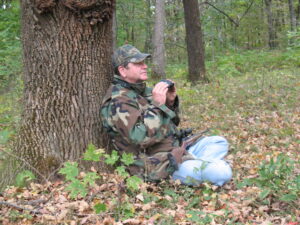
waiting
A pair of binoculars helps view wildlife, but the movement to raise them to the eyes sometimes scares away animals. Rich often wears his hearing aids to accentuate sounds that add to the experience.
Remember the Wonders of Darkness
At Winding Pathways, we sometimes sit outside after dark. As soon as our eyes adjust to low light, we occasionally spot deer, opossums, and raccoons prowling in the yard. The best wildlife viewing is when the moon casts some light. However, the best star viewing is during the moon’s dark phase. That comes with a bonus. Since the stars aren’t spooked by our movement we can make all the noise and motion we want and they stay majestically above us.
So, here’s our suggestion: Go outside and embrace the stillness and dark.










